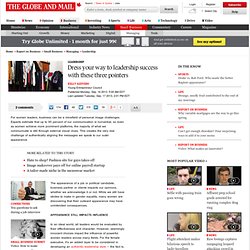

Which Women Are Rising to the Top? - M. Ellen Peebles. By M.

Ellen Peebles | 10:00 AM March 18, 2014 It’s the responsibility of management to tackle gender diversity, Avivah Wittenberg-Cox recently wrote on this site. Stop blaming women for what they do or don’t do, she argues, and train leaders to manage and develop a more balanced workforce. She makes a great point. Any cultural shift goes much more smoothly with the active involvement of the CEO and his or her (usually his) team.
But the evidence suggests that our leaders aren’t doing a very good job of it, at least not yet. For one, these executives take the time to explore what they want out of work and life. One byproduct of this effort is that they pay special attention to how they might fit within a company’s culture. Another quality these women share is that they take responsibility for their choices—including the sacrifices they’re willing to make. As a Leader, Create a Culture of Sponsorship - Sylvia Ann Hewlett. By Sylvia Ann Hewlett | 11:00 AM October 8, 2013 Sexual tension will always exist in the workplace.

Affairs happen, and where there’s even the possibility of sex, there’s gossip. Sex — or the specter of it — haunts sponsorship, prompting men and women to avoid the professional partnerships necessary to achieve their career goals for fear of being censured, fired, or sued. My research shows that 64% of senior men (vice president and above) and 50% of up-and-coming women admit they’re hesitant to initiate any sort of one-on-one with each other lest their motives be misconstrued by their colleagues and rumors start poisoning the workplace.
When affairs — or even the perception of one — are present, 70% of women surveyed say the junior female disproportionately bears the brunt, and 53% of male respondents agree. But while women need to consider the challenges posed by sex, scandal, or innuendo, the responsibility for keeping the relationship safe shouldn’t rest solely on their shoulders. Dress your way to leadership success with these three pointers. For women leaders, business can be a minefield of personal image challenges.

Experts estimate that up to 95 percent of our communication is nonverbal, so even as women achieve more prominent platforms, the majority of what we communicate is still through external visual clues. This creates the very real challenge of authentically aligning the messages we speak to our outer appearance. The appearance of a job or political candidate, business partner or clients impacts our opinions, whether we acknowledge it or not.
While we still have strides to make in gender equality, many women are discovering that their outward appearance may have unintended consequences. Marissa Mayer Biography. A Fairer Way to Make Hiring and Promotion Decisions - Jean Martin. By Jean Martin | 8:00 AM August 13, 2013 Nearly eight out of 10 executives say diversity is increasingly important in helping them achieve business goals — and they’re demonstrating strong support for it.

There are external social and legislative pressures driving this emphasis, but the bottom line is that diversity is good for business. CEB research found that in a more diverse and inclusive workforce, individual discretionary effort improves by 12%, the number of people who say they intend to stay at their firm increases an average of 20% and fully 50% more employees say they are committed to their team and that their teams collaborate well. Women: Let's Stop Allowing Race and Age to Divide Us - Ancella Livers and Trudy Bourgeois. By Ancella Livers and Trudy Bourgeois | 9:00 AM August 15, 2013 When we talk about the barriers that prevent female leaders from getting to the top, we often ignore one uncomfortable truth: women often let their racial and generational biases prevent them from helping each other.

“I’m rejected,” one white millennial woman told us. “Women at the top don’t understand me and won’t take the time to get to know me. I’m not only excluded from the good ol’ boys club but also disconnected from the people I thought I could count on — other women.” “The tensions are not recognized or talked about,” we heard from an Asian-American management consultant. For young women and women of color, the discriminatory tendencies of some men (both conscious and unconscious) are not the only issue. The good news is that we think it stems from benign neglect rather than bold prejudice. These eight action steps will help: Women Rising: The Unseen Barriers. Photography: Courtesy of Janus van den Eijnden.

Artwork:Janet Echelman,1.26 Sculpture Project at the Amsterdam Light Festival, December 7, 2012–January 20, 2013, Spectra Fiber, high-tenacity polyester fiber, and lighting, 230' x 63' x 30', Amstel River, Amsterdam, Netherlands Many CEOs who make gender diversity a priority—by setting aspirational goals for the proportion of women in leadership roles, insisting on diverse slates of candidates for senior positions, and developing mentoring and training programs—are frustrated.